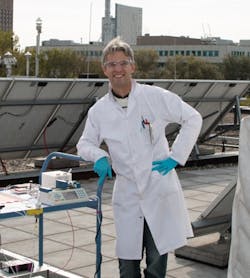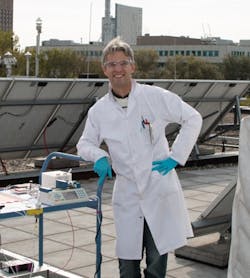Photoreactor Overcomes Sunlight Variation
Researchers at Eindhoven University of Technology, Eindhoven, The Netherlands, have improved the microphotoreactor they developed to use solar energy and microchannels to manufacture pharmaceuticals (see: Artificial Leaf Spurs Energy-Efficient Reactions). Now, the team reports their “mini-factory” can keep production at the same level, regardless of variations in sunlight due to cloudiness or time of the day.
Figure 1. Timothy Noël of the Eindhoven University of Technology monitors the natural sunlight experiments conducted on the rooftop of a university building. Source: Eindhoven University of Technology.
In their original work, the researchers took a cue from nature and used a relatively new material called a luminescent solar concentrator to capture and store sunlight similar to the way plants operate. In this material, they then applied very thin channels, through which liquids are pumped, thereby exposing the liquids to sufficient sunlight to allow chemical reactions to take place. The end products flow out at the extremities of the channels.
However, a significant challenge to any solar-based device is the daily — even hourly — fluctuation of sunlight available. To address this, the researchers have designed a real-time feedback system costing less than €50 (under $60) that automatically slows down or speeds up production.
“If there is too much light, you get unwanted byproducts, and if there is too little light, the reactions do not take place or do so too slowly,” explains lead researcher Timothy Noël. “Ideally, the system should automatically adapt to the amount of incoming sunlight.”
The real-time reaction control consists of three simple elements: a sensor measures the amount of light reaching the channels; a microcontroller translates this signal into a pump speed; the pump then drives the fluids through the channels at that speed. To optimize the feedback loop, the researchers conducted experiments to determine the required pump speed for a specific light intensity.
The team tested the system in both artificial and natural light settings. At a yield setting of 90%, the system kept production stable for an hour at between 86% and 93%. The same system without feedback looping varied drastically between 55% and 97%. With the feedback loop, the average yield increased by about 20%. A recent article in Green Chemistry has more detail on these results.
According to Noël, this brings a cheap and sustainable reactor considerably closer to producing chemical products on a large scale, with only sunlight as an energy source. “It is inevitable that energy prices will rise; with a source of energy like the sun that is free and available, these kinds of technological solutions can make the difference.”
The researchers also addressed one other challenge from their original work. To minimize maldistribution, they needed to find a way to ensure equal pressure drop in the different channels. So, to overcome high pressure drops within the largest devices, the team developed a numbered-up LSC-PM design with a bifurcated flow distributor and collection chamber. Details on this development can be found in an article in ACS Sustainable Chemistry & Engineering.
The researchers haven’t yet partnered up with industry to bring this technology to the market. “We certainly would love to do that in the near future and welcome hearing from potential investors,” says Noël.

